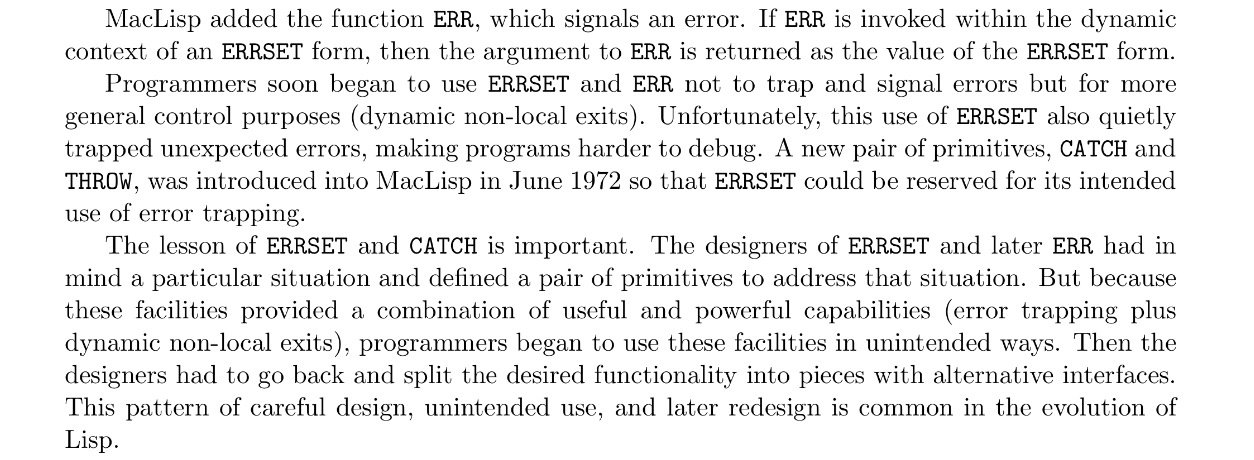Question for the etymology wizards out there: which programming language was the first to use the try/catch/finally syntax found in today's Java/.NET languages?
I believe it was C++ and I think Java/C# added finally for resource cleanup (finally is not in C++). Unfortunately I have no references... yet.
Neat page of all the exception syntax: http://en.wikipedia.org/wiki/Exception_handling_syntax
I believe it is C++. If its not then Stroustrup needs to give credit. In his paper: http://www.research.att.com/~bs/except.pdf He does not mention any influences and does not reference any other material other than his own.
finally in C++, is there? –
Cystocele Try::Tiny, a Perl module that is one of the de facto standards for exception handling in that realm, makes use of the try-catch-finally syntax but gives it completely different semantics. I wanted to make sure I had my history straight before I dissed it. –
Footstep Posted on Twitter by Mike Fikes, shared with me by Paweł Kapała:
MacLisp added the function
ERR, which signals an error. IfERRis invoked within the dynamic context of anERRSETform, then the argument toERRis returned as the value of theERRSETform.Programmers soon began to use
ERRSETandERRnot to trap and signal errors but for more general control purposes (dynamic non-local exits). Unfortunately, this use ofERRSETalso quietly trapped unexpected errors, making programs harder to debug. A new pair of primitives,CATCHandTHROW, was introduced into MacLisp in June 1972 [emphasis mine] so thatERRSETcould be reserved for its intended use of error trapping.The lesson of
ERRSETandCATCHis important. The designers ofERRSETand laterERRhad in mind a particular situation and defined a pair of primitives to address that situation. But because these facilities provided a combination of useful and powerful capabilities (error trapping plus dynamic non-local exits), programmers began to use these facilities in unintended ways. Then the designers had to go back and split the desired into pieces with alternative interfaces. This pattern of careful design, unintended use, and later redesign is common in the evolution of Lisp.
— from “The Evolution of Lisp,” by Guy Steele and Richard Gabriel
 Source: https://twitter.com/mfikes/status/881943130588753920
Source: https://twitter.com/mfikes/status/881943130588753920
<blockquote class="twitter-tweet" data-lang="en"><p lang="en" dir="ltr">“The Evolution of Lisp,” by Guy Steele and Richard Gabriel</p>— Mike Fikes (@mfikes) <a href="https://twitter.com/mfikes/status/881950560508940288">July 3, 2017</a></blockquote>
<script async src="//platform.twitter.com/widgets.js" charset="utf-8"></script>C++ was the first major programming language to introduce exceptions (finally is not needed in C++ because destructors are deterministic). From Stroustrup's paper: http://www2.research.att.com/~bs/hopl2.pdf
the greatest influence on the C++ exception handling design was the work on fault−t olerant systems started at the University of Newcastle in England by Brian Randell and his colleagues and continued in many places since
unwind-protect, of course with a very different syntax. There were more recognizable exceptions in Algol 68 and CLU, but with different keywords (not try and catch). –
Pelargonium Common Lisp predates C++ by a long time, and was based earlier Lisps. Java was, of course, created by Lisp men who were very aware of this. But Java is Lisp polluted by C, so they also added the checked exception specification nonsense.
Common Lisp went further and actually enabled the catch to interact with the throw routine, including to tell the throw to continue. The stack was simply not unwound until the catch was done. That meant you could throw warnings like low memory as well as throwing fails.
© 2022 - 2024 — McMap. All rights reserved.
